This content originally appeared on Bits and Pieces - Medium and was authored by Jonathan Saring

During the past 4 years I have worked with dozens of platform teams including the world’s largest organizations, tackling the most large-scale and complex problems in modern software development. I learned a lot.
This guide is the practical and key essence of my knowledge and experiences. It lists and shows the required capabilities, solutions, and tools that allow us and the organizations I work with to succeed.
I hope this will be handy to you; my only ask is that you do no hesitate to share your own insights, stories and experience with the rest of us too. You can do so in the comments below, I will read them all I promise. Enjoy 🙏
Building an internal developer platform
Internal Developer Platforms (IDPs) are no longer just a nice-to-have — they’re essential. As development teams grow, and complexity mounts with distributed systems, micro-services, and global operations, having a central hub that orchestrates the entire software lifecycle becomes critical.
IDPs are designed to simplify processes, standardize tools, and reduce friction, all while empowering developers to build, test, and ship faster. They eliminate bottlenecks by providing a self-service layer that developers can tap into without waiting for manual interventions from infrastructure teams, build and ship new products, and collaborate with each other.
When done right, a good platform provides critical benefits including:
- Faster delivery and rapid innovation
- Standardized and consistent development
- Increasing cost-efficiency and ROI
- Scalability, security and compliance
The team tasked with building and growing this platform is often the platform team. The platform team consists of platform engineers who are tasked with providing a dev infrastructure to the organization including:
- Templates and starters — with built-in guardrails and best standards — for creating new software components in the organization.
- Components and reuse — Components are building blocks, from micro-services to micro-frontends, UIs and everything in between. Provide components and make it easy to create, find, and (re)use components — and easily manage versioning, dependencies and packages at scale. Developers should have access to ready-made components via package registries and easily create new components on the portal.
- Developer portal — Developers should access a central hub that provides discovery, documentation, and collaboration over components.
- CI/CD and infra as code — Developers in the organization should have automated pipelines and workflows with zero ops required.
- Standardization and governance — Development in the organization should be standardized, and the platform team should have visibility and analytics into the technology developed, its usage, and impact.
- Dev experience and onboarding — Developers should easily and quickly onboard to the platform, create use or edit components, and more.
Composability is Your Future X-Factor
Choosing the right solution for your IDP is crucial. The right solution should be a good fit for your current needs, and also future-ready your organization. The right solution should therefore be composable.
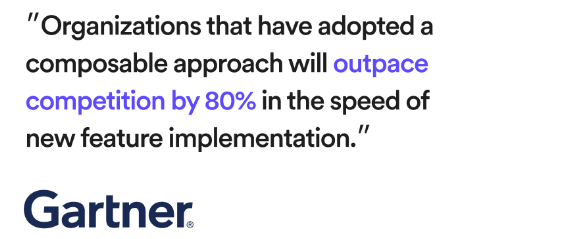
With the rise of composability and component-driven development (CDD), platforms like Bit offer a way to build these platforms efficiently.
First, an example — meet the “Acme” platform
In this guide, I will show how all of these capabilities — and more — become possible and simple to provide with a composable platform like Bit. We’ve been building with it for 4 years now, and so do hundreds of organizations including many (many) platform teams from Fortune-100 organizations.
You can go ahead and explore this examples organization named “Acme”:
Bit. Composable software platform.
In a quick look you will see its different scopes:
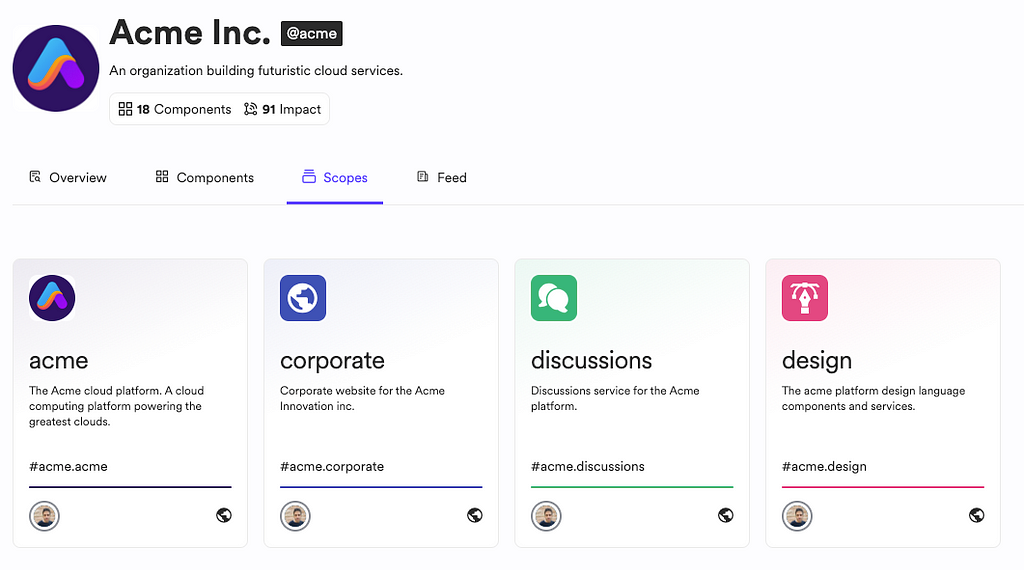
And click on the “Discussions” scope, where all components of the “discussions” domain — front and back — are available:

Interesting? Great :) Let’s dive into the components of building a great developer platform, and how platforms like Bit provide them 🏊
1. Templates and Starters for Speed and Consistency
One of the main tasks of any platform team is to provide developers in the organization with tools that will help them to create new software products and features, but in a much faster, easier and consistent way.
A developer platform starts by providing standardized development environments and templates that help onboard developers quickly and enforce best practices. These “tools” include mainly two components:
- Creating Templates and starters
- Creating Dev environments
1.1 Templates and Starters
Templates and starters are crucial for establishing a standardized approach to development, helping teams avoid redundant work while ensuring consistency across projects. They provide developers with predefined structures for everything from micro-services to frontend components, streamlining the creation process and enforcing best practices.
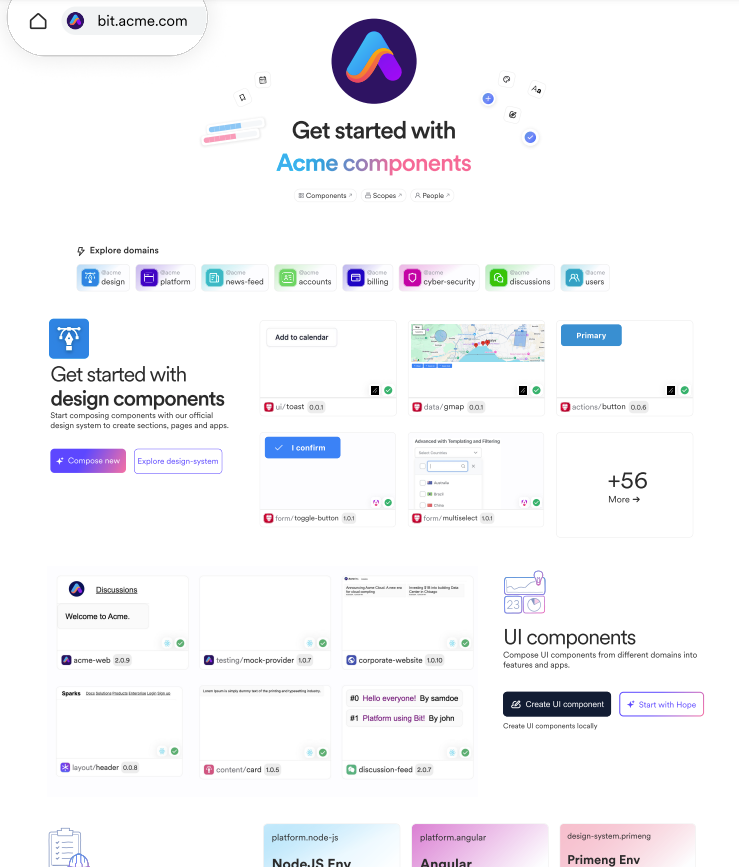
Bit simplifies the process of using templates by allowing platform teams to create reusable, versioned templates that follow organizational standards.
These templates can be for any type of project: micro frontends, UI components, business logics, micro-services etc. Developers can start new projects using these templates directly within the platform, eliminating setup times and ensuring consistency across teams and projects.
Templates are components that can be versioned and updated. If an update is needed, changes can be applied across projects automatically. For example, a React template might include routing, state management, and a CI/CD pipeline, all pre-configured to meet your organization’s security and performance guidelines. This template can be reused across projects, reducing setup time and ensuring adherence to best practices.
1.2 Dev Environments
A robust developer platform provides standardized development environments that onboard developers quickly and enforce best practices.
Bit’s platform supports reusable dev environments tailored to different tech stacks like React, Angular, and Node.js. Developers can easily customize and reuse these environments, which are distributed across teams to ensure consistent setups for new features and initiatives.
The platform team provides reusable development environments that are pre-configured for different tech stacks (e.g., Node.js, React, or Angular). These environments ensure consistent tooling and configurations across the entire development team, removing the “works on my machine” issue.
With Bit’s cloud-based environments, you can spin up development environments quickly and start coding immediately. These environments are also versioned, ensuring that updates can be rolled out smoothly.
1.3 Web dev workspaces for creating and reusing components
Bit’s cloud workspaces allow developers to code, collaborate, and release from any device without the need for local installations. These workspaces enable real-time collaboration with built-in version control, previewing, and commenting, making it easy for distributed teams to work together.
Developers can code directly in the browser, with immediate feedback and previews of changes. Bit’s cloud workspaces help speed up dev onboarding and development by eliminating complex setup processes, allowing developers to build and ship features faster. At any time, components and scopes can be imported into your local workspace, and vice versa.
2. Reusable Components (Front and Back)
Reusable components are the cornerstone of an efficient developer platform. Reusable building blocks reduce redundancy, improve code consistency, and ensure maintainability.

A basic and critical task of the platform engineering team, and of its developer platform, is to provide developers in the organization with components: micro-services, micro-frontends, UIs, features, business logic and more. In addition, these components — and the ones added by other developers using templates — should be instantly and seamlessly reusable.
Efficiently reusing these components not only speeds up development but also ensures consistency across digital products and experiences. Managing components effectively — along with their versions and dependencies — is key to scaling a development organization.
Capabilities and Challenges
Managing components involves ensuring their discoverability, reusability, dependencies, and version control. A challenge arises in keeping components up to date and compatible across multiple products while avoiding duplication. Your developer platform should provide solutions for all of these requirments, and automate this process as much as possible.
2.1 Components
Bit allows developers to create reusable software components by providing a platform designed for component-based development.

These components are isolated, versioned, and can be shared across different teams within the organization. This benefits platform teams and developers by reducing duplication of work, ensuring consistency, and accelerating time-to-market. With reusable components, teams can collaborate more effectively, as each component can be reused in multiple projects, enhancing efficiency and maintaining product quality.
2.2 Component Reuse and Packages
Automated packaging of reusable components
Bit automates the packaging process of reusable components by managing the build and versioning of each component through a CI/CD pipeline. This pipeline ensures that only changed components are built, reducing unnecessary rebuilds and providing a streamlined update process. For platform teams and developers, this automation minimizes manual errors, increases deployment speed, and ensures components are always ready for use across projects.
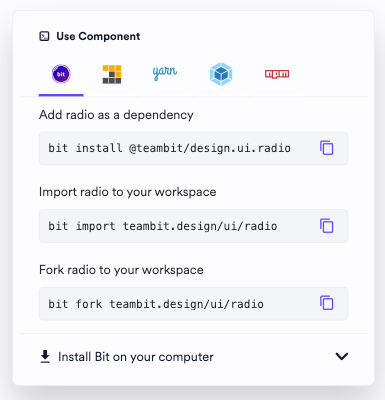
In addition, Bit streamlines the reuse of components by allowing them to be consumed from the built-in Bit registry or any other configured private registry. Developers can use any package manager to install components, making them versatile and easy to integrate into different projects. Additionally, Bit supports micro frontends, enabling components to be integrated at runtime using techniques like module federation. This ensures that components can be seamlessly consumed and reused across the entire organization, improving efficiency, speed and consistency.
2.3 Automated Component Versioning
A developer platform should provide versioning for software components to ensure that updates to components can be safely introduced without disrupting the rest of the system. This allows teams to track changes, revert to previous versions, and maintain a stable development environment.
Bit allows automated versioning of components using Semantic Versioning (semver), which helps in managing component updates and dependencies across an organization. Each component can be independently versioned, edited, and updated, enabling teams to use different versions of the same component in various projects without conflict. This means better collaboration and less risk of breaking changes affecting multiple projects.
2.4 Automated Dependency Management
Dependency management is critical for scaling software development, especially when dealing with complex monorepo or polyrepo architectures. Bit provides automated dependency management by detecting and managing dependencies at the component level, ensuring that the right versions of dependencies are used.
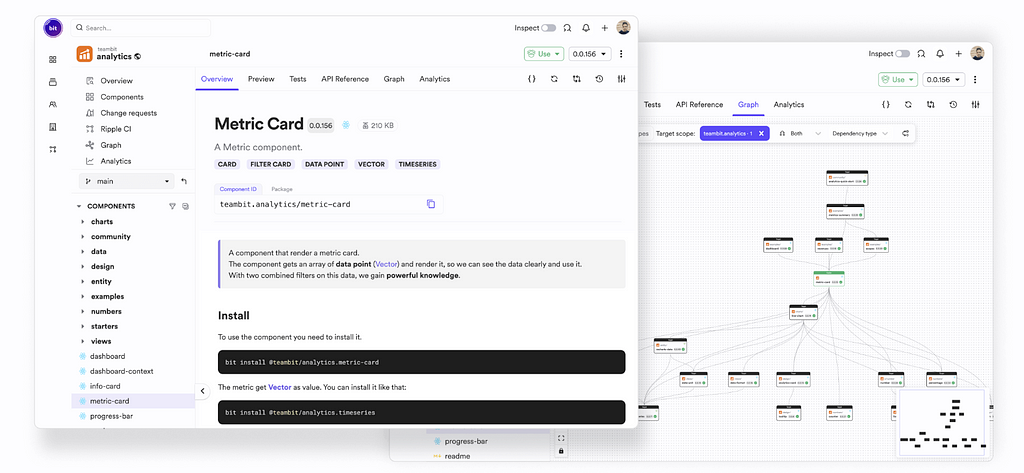
Bit dynamically generates the necessary package.json — which you don’t have to manually handle or config — and automatically tracks the relationships between components. If you “bump” a version for a component used by another component, Bit “knows” that the second components depends on the first one, and will ask you to OK the update.
This is beneficial in monorepos as well as multi-repo architecture. Bit handles version consistency across all components without the typical "phantom dependencies" issue seen in traditional package managers like npm. The team gets visibility and control over dependencies through its workspace, so developers can ensure consistent and efficient builds.
2.4 Cost Efficiency and ROI
A scalable developer platform should allow reuse, standards, faster onboarding, and faster delivery — while consuming fewer organizational and development resources. This is where components shine once again.
In a case study conducted in 2023 by the largest telecom provider in the US, reusing Bit components saved well over $100,000,000 a year using just 2k components 💵 Read more about it here.
Another example is a large Canadian healthcare organization, which doubled (x2.2) the number of apps delivered, and reduced the cost per new application by 80%, within 12 months — using only 36 components!
By reusing components across projects, a platform like Bit helps organizations reduce development costs, in a few different ways:
- Reusing ready-made components saves time and costs.
- Reusing components prevents bugs and mistakes.
- Reusing components means faster TTM and more revenues.
- Reusing components reduces TTR for bugs in the system.
3. Developer Portal
A developer portal within an internal developer platform serves as a central interface where developers can access all the resources, tools, and information necessary for efficient software development.
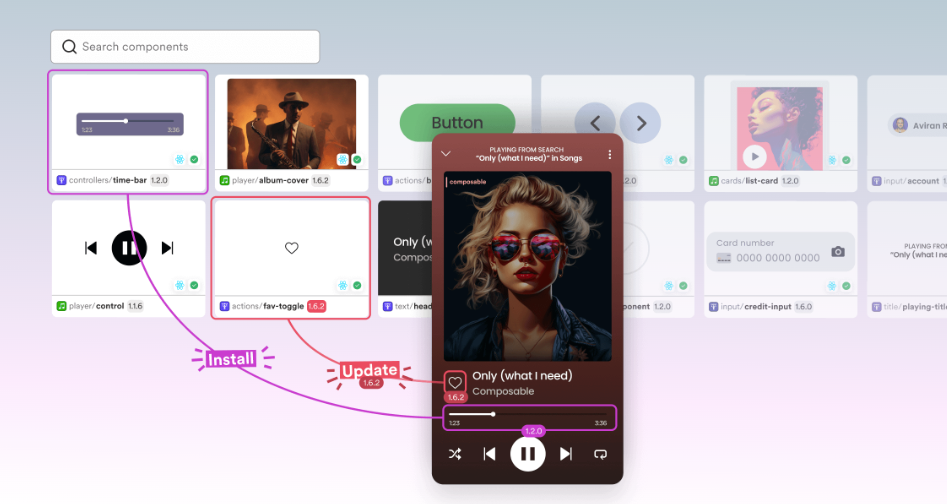
Required capabilities that may not be provided by the rest of the platform include: centralized hosting for components, component discovery (search, catalog, etc.), and automated documentation for components.
Bit provides these capabilities through its cloud-hosted platform, where every software component is centrally stored and easily accessible.
It offers built-in tools for component discovery, including a search engine, catalog, and scopes that organize components by business domains.
Additionally, Bit automatically generates and maintains detailed documentation for each component, such as usage guidelines, code snippets, and versioning history. These features allow platform teams and developers to find, use, and collaborate on components more efficiently, enhancing the reusability of code across the organization(GenericBitIntro).
3.1 Discovery
Finding reusable components is essential for maximizing efficiency.

A developer portal must enable component discovery because efficient reuse of components can drastically reduce development time and increase consistency across projects.
Bit allows for scalable and simple component discovery through its integrated features such as search, catalog, and scopes, enabling developers to quickly locate relevant components.
This facilitates better collaboration and ensures that developers across the organization can find and use components without duplicating effort, thereby optimizing the speed and quality of the development workflow.
3.3 Documentation
Keeping documentation in sync with component versions is a common pain point. Bit solves this by auto-generating documentation for every component, tied to its current version. Each component’s page includes:
- API references — Learning how to use a component.
- Usage examples — Quickly learning with examples.
- Test results — to learn how components behave n different cases.
- Visual previews — Preview components visually in different contexts.
- Dependencies — View dependencies and dependents for components.

Bit ensures that developers always have the most relevant, up-to-date documentation, which automatically updates with component changes. For instance, when a new prop is added to a React component, the documentation reflects this without manual effort.
As components evolve, the documentation stays in sync, reducing confusion and outdated info. Bit’s developer portal streamlines access to this documentation, along with discovery and collaboration tools, boosting team efficiency and maintaining consistency across projects. This fosters better quality and scalability in component-driven development.
4. Collaboration
A developer platform should facilitate collaboration between developers, designers, and product managers (PMs) to ensure smooth, consistent workflows across all aspects of a project. The key capabilities for such collaboration include shared component libraries, real-time feedback, and integrated workflows.

Bit fosters collaboration by enabling cross-functional teams to work together on a centralized platform, where components are easily accessible, documented, and versioned. Bit’s cloud hosting, integrated CI/CD, and shared component registry ensure that all stakeholders can collaborate on the same components, contributing to improved communication, faster feedback loops, and consistency across projects
4.1 Contributions
Making it Easy to Suggest New Components or Changes: For a developer platform to be effective, it must allow developers to propose new components or suggest changes to existing ones easily.
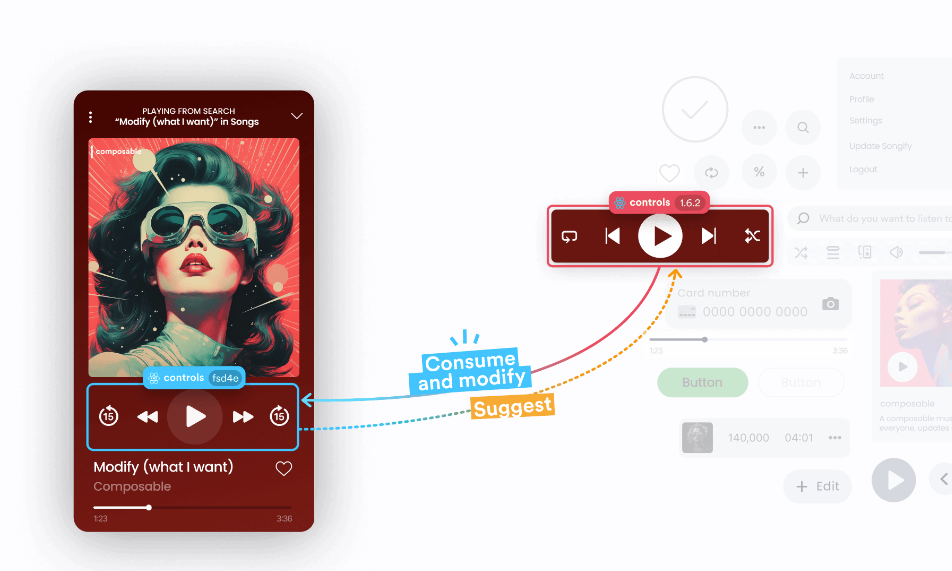
Bit provides this capability through its use of lanes and change requests, which enable developers to create isolated workspaces for experimentation without affecting the main project.
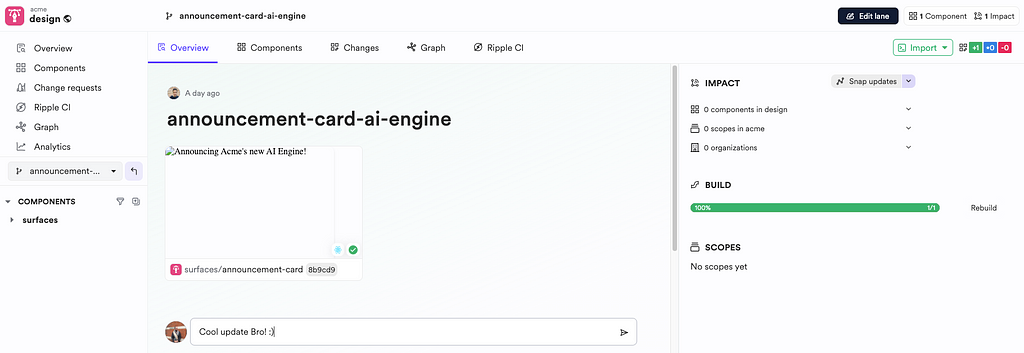
These features allow developers to make suggestions, test changes, and collaborate on improvements before merging them into the main codebase. This approach helps ensure that new components or updates are properly vetted, promoting innovation while maintaining stability.
4.2 Reviews
A developer platform should simplify the process of reviewing and discussing component changes to ensure quality and alignment.
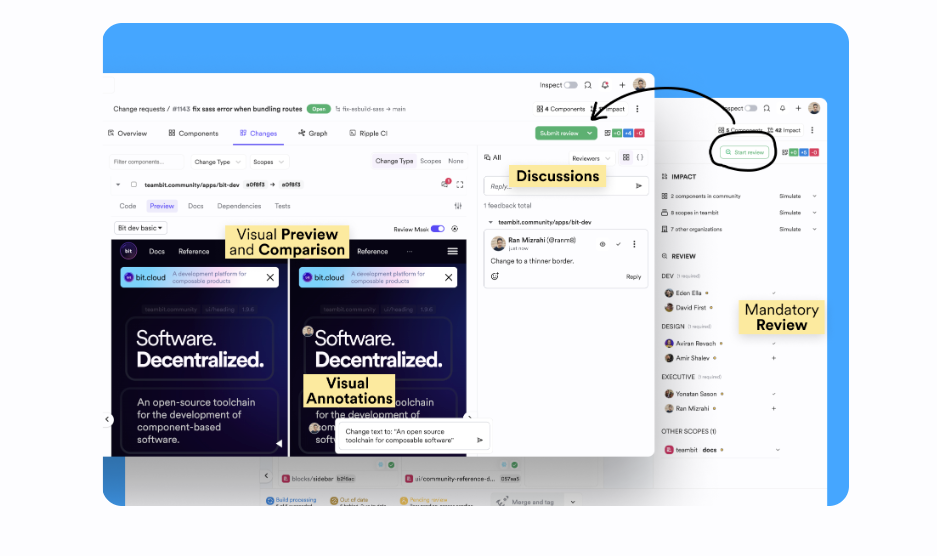
Bit provides tools like component previews, change requests, and discussions within workspaces. Developers and stakeholders can visually review changes, provide feedback, and discuss improvements before finalizing updates. This fosters control by ensuring only approved changes are merged, allowing organizations to define clear approval processes, reducing risk, and increasing accountability
4.3 Fostering a Shared Component Economy
A developer platform should encourage a component economy by enabling teams to share, reuse, and improve components across the organization. Imagine having a component cloud for everyone to share components.
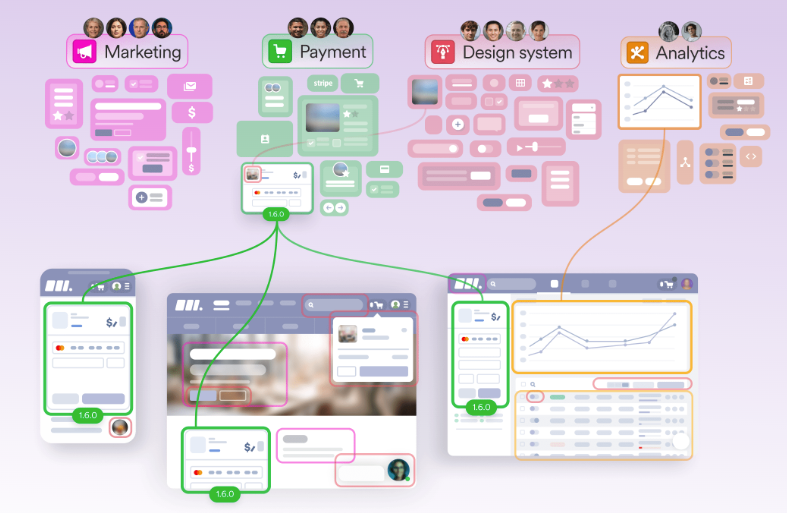
Bit supports this economy by offering a centralized registry for reusable components, making it easy for teams to find, share, and integrate components. The platform’s automated versioning, documentation, and scalable architecture further enhance reuse, enabling organizations to reduce development time and maintain high-quality standards.
5. CI/CD and Infrastructure as Code
A robust CI/CD pipeline and well-defined Infrastructure as Code (IaC) are essential for automating the development, testing, and deployment processes. By integrating these into the platform, developers can focus on coding without worrying about operational overhead. Automation ensures that all components are continuously built, tested, and deployed efficiently.
Bit provides these capabilities by integrating a zero-ops CI/CD pipeline that works automatically, removing the need for developers to manually configure their environments. It also provides version control and dependency management, ensuring that teams can ship changes faster while maintaining high product quality.

Through its infrastructure-as-code model, Bit simplifies project setup and management by automating routine tasks, reducing time spent on configurations and minimizing errors and time waste.
5.1 Zero-Ops Builds
A developer platform should make it easy for developers to run builds and deployments without requiring complex operations, which is where Bit excels with its zero-ops approach. The key features that make this possible include:
- Build Pipelines: Bit automatically builds and tests components, ensuring that they are always production-ready.
- Ripple CI/CD: This feature allows developers to automatically handle builds, only triggering builds for components that have been changed. This minimizes build time and resource usage, helping teams deploy faster with fewer bottlenecks.
5.2 Ripple CI
With Ripple CI, developers can focus purely on writing and improving code, as the platform automates all aspects of the build and deployment process. This feature also ensures that changes are seamlessly integrated, tested, and delivered to production without manual intervention.
Ripple CI, integrated into Bit, offers a number of advantages that make it a standout CI/CD solution:
- Zero-Ops: No manual setup or configuration required.
- Component-Based Builds: Only the components that have been modified are rebuilt, saving time and resources.
- Cross-Organizational: Ripple CI handles builds across multiple teams and projects, enabling collaboration on a large scale.
- Incremental and Resumable: Builds can be resumed from the point of failure, improving efficiency.
- Lightning Fast: The incremental build process ensures that updates are processed rapidly.
- Pinpoint Failures: Since Bit focuses on individual components, any issues can be quickly isolated and resolved at the component level.
These features make Ripple CI a powerful tool for organizations looking to optimize their development and deployment processes, particularly in environments where speed, collaboration, and resource efficiency are critical(GenericBitIntro)(GenericBitIntro).
5.3 Infrastructure as Code
Bit.cloud provides Infrastructure as Code (IaC) capabilities by automating the entire development and deployment workflow. This includes:
- Customizable Environments: Developers can define custom environments tailored to their projects.
- Automated Versioning: Ensures that all components are versioned correctly and consistently across projects.
- CI/CD Integration: Built-in CI/CD pipelines automate testing, building, and deployment, ensuring that all components are ready for production without manual intervention.
5.4 Bring your own CI/CD
A developer platform should be flexible enough to integrate with popular CI/CD tools and accomadate the workflows required by large teams.
Here’s how it’s done with the Bit platform:
6. Visibility, Governance, and Control
A developer platform must provide platform teams with clear visibility and governance over software and its components to maintain a high level of control and insight. This includes:
- Detailed Analytics on Component Usage: Bit offers real-time insights into which components are used most, helping teams optimize usage and ensure consistent performance across projects.
- Standardizing and Regulating Development: Bit enforces standard tools and workflows via customizable environments and reusable templates, ensuring best practices across teams.
- Visibility into Digital Assets for Leadership: Leadership gains real-time visibility into component health and usage trends through Bit’s dashboards, aiding in strategic decision-making.
- Tracking and Enforcing Security and Compliance Standards: Bit embeds security and compliance into templates and workflows, ensuring all components meet regulatory standards with auto-checks.
6.1 Usage and Impact Analytics
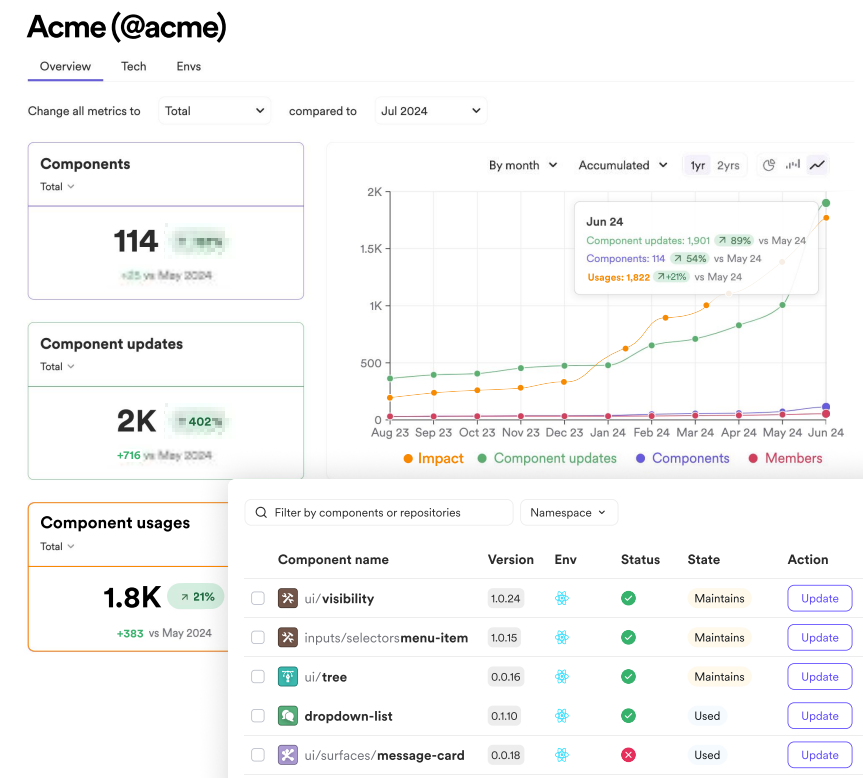
Platform engineers need easy access to analytics that help monitor the usage, impact, and adoption of components. Bit provides built-in tools:
- Component Usage Tracking: Engineers can easily see which components are most widely used, ensuring the most effective parts of the codebase are leveraged.
- Adoption Rates: Tracking how often updates and new features are adopted across teams helps engineers ensure that the right changes are being implemented organization-wide.
- Technology and Environment Monitoring: Bit allows platform engineers to track the technologies and environments being used by teams, which helps optimize the tech stack and ensure standardization.
6.2 Standardizing and Regulating Development
Standardizing development processes is essential to maintain product quality and development efficiency across an organization. Bit makes it easy for platform teams to:
- Enforce Development Standards: By customizing environments, Bit ensures that all teams use the same tools and technologies, preventing fragmentation in the development process.
- Create Standardized Templates: With reusable templates, platform teams can ensure that best practices are followed across all development projects, increasing the quality and reducing the risk of errors.
- Centralize Development Pipelines: Centralized control allows platform engineers to manage and optimize pipelines effectively, reducing overhead and improving release cycles.
6.3 Visibility into Digital Assets for Leadership
Leadership teams need real-time visibility into the organization’s digital assets to make data-driven decisions and understand the impact of reusable components. Bit provides:
- Real-Time Dashboards: These offer leadership a snapshot of the status and usage of components across various teams and projects, enabling better decision-making regarding investments in specific features.
- Impact and Efficiency Insights: Leadership can evaluate the effectiveness of reusable components in reducing development time and costs, ensuring that the organization is maximizing digital assets.
6.4 Tracking and Enforcing Security and Compliance Standards
Ensuring security and compliance is critical, and a developer platform must provide tools to make this easy. Bit allows organizations to:
- Embed Security and Compliance into Component Templates: By building security standards directly into templates, Bit ensures that each new component complies with organizational security policies from the start.
- Enforce Compliance Across Teams: Security and compliance are built into the development environments, ensuring that these critical standards are applied consistently across all projects.
- Specialized Components for Security: Bit also supports the development and deployment of designated components for sensitive tasks like authentication and authorization, ensuring compliance with regulatory requirements in a consistent way across the organization.
7. Integrations and Plugins
A developer platform should offer pluggability to allow teams to extend its functionality by easily adding new features and integrating external tools.
This flexibility is crucial because development workflows often evolve, requiring new tools, CI/CD pipelines, or collaboration integrations.
Bit provides these capabilities by supporting a modular architecture, where features can be added as plugins or “aspects.” It also support integrations.

These aspects allow teams to tailor the platform to their specific needs without disrupting existing workflows. Bit also integrates seamlessly with tools like Git, Slack, CI/CD pipelines, and project management tools such as Jira and Monday. This integration fosters collaboration by ensuring that the platform adapts to the diverse toolsets used within an organization.
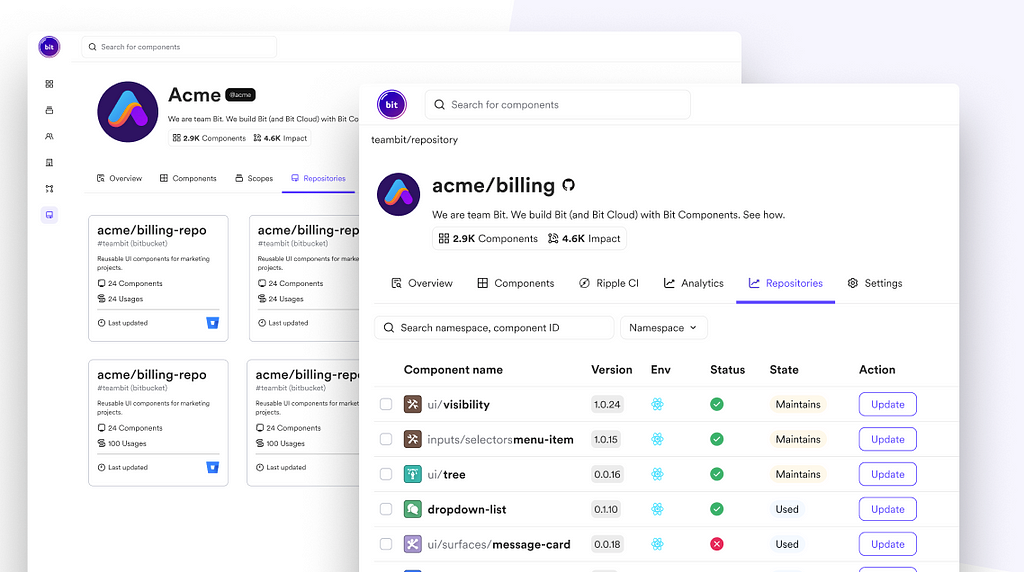
7.1 Adding Plugins and Features
A developer platform should make it easy to add plugins and extend features to accommodate evolving business and technical needs.
Bit enables this through its aspects system, which allows developers to add new capabilities such as custom build environments, testing frameworks, and deployment automation. These aspects are highly configurable, making it easy to implement new functionality across teams. By offering pluggable extensions, Bit enables organizations to evolve their practices while maintaining consistency and efficiency across all projects.
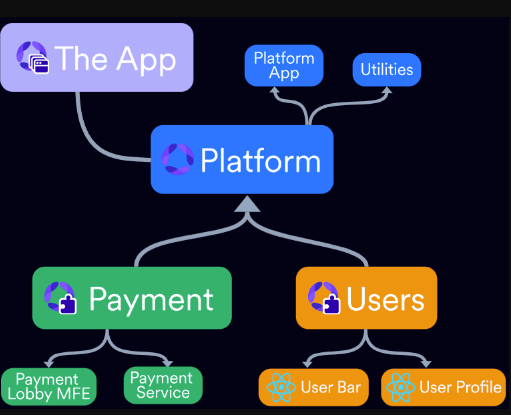
7.2 Integrating External Tools and Workflows
Seamless integration with external tools and workflows is key for maintaining an efficient development process. A developer platform should easily connect with tools such as Git hosting (GitHub, GitLab, Bitbucket), registries (npm, Docker), CI/CD tools (Jenkins, CircleCI), collaboration tools (Slack), and task management tools (Jira, Monday).
Bit supports these integrations by allowing teams to plug into these systems directly, managing PRs, updates, and builds within the same environment. This ensures that developers can automate processes, collaborate across tools, and streamline their workflows.
Bit also provides deep integrations with IDEs like VSCode, allowing developers to manage and build components directly from their code editor. This IDE integration eliminates the need to switch between tools, providing a faster and more focused development workflow.
For example, developers can track changes, version components, and trigger builds from within VSCode, ensuring that their local workflow aligns perfectly with the larger platform.

8. AI Component Creation, Reuse, Docs and More
A developer platform should natively support AI to enhance the entire development lifecycle. Key capabilities for AI integration include the ability to create components using templates, reuse existing components, generate automated documentation, and add tests.
Bit addresses these needs with its AI-powered assistant, Hope AI, which assists developers in creating, editing, reviewing, and documenting components. By being context-aware, Hope AI can suggest relevant components, streamline the creation process, and ensure components are properly documented and tested. This capability fosters collaboration and efficiency by providing a seamless workflow from the web, making the development process fast and simple.
8.1 AI-Driven Component Creation
A developer platform should make it easy to create new components using AI, while preventing duplications and ensuring consistency.
Bit’s Hope AI helps developers quickly create managed components that are treated as reusable packages. This managed approach eliminates the risks associated with copy-pasting code, which often leads to inconsistent and unmaintainable software. Copy-pasting AI-generated code can introduce errors, duplicate work, and even security vulnerabilities. By generating components that are managed and versioned, Bit ensures consistency, reliability, and scalability across teams and projects(GenericBitIntro)(GenericBitIntro).
8.2 AI-Powered Reuse and Composition of Components
Bit enables easy reuse and composition of components through its context-aware AI system, which identifies relevant components and suggests them during the development process.
Hope AI understands the relationships between existing components and how they can be leveraged to create new features or enhance current ones. This drives code reuse by eliminating duplications, reducing development time, and promoting consistent, maintainable codebases. By automating the reuse of components, Bit ensures efficiency and scalability, allowing teams to avoid redundant work while improving overall code quality.
8.3 AI-Driven Documentation, Tests, and Dependencies
A developer platform should enable AI-driven automation to keep documentation, tests, and dependencies consistently up to date.
Bit’s Hope AI automates these processes, generating and maintaining accurate documentation, running tests, and managing dependencies without manual effort. This ensures that all component changes are reflected in real time, reducing errors, enhancing code quality, and enabling faster development cycles.
Automated documentation improves communication across teams, while dependency management avoids compatibility issues. By leveraging AI, Bit enhances productivity by letting developers focus on building features rather than maintaining documentation and test suites, driving both efficiency and reliability in development workflows.
Conclusion
e’ve covered a lot, from reusable components to AI automation. Building a developer platform isn’t just about solving today’s problems — it’s about being future-ready. As teams grow and complexity rises, you need a platform that can scale, keep things consistent, and support collaboration.
With Bit’s composable architecture, that journey becomes easier. Hope AI automates the tedious work like documentation and testing, allowing developers to focus on what matters most — building and innovating. Its component reuse, CI/CD pipelines, and seamless integrations make Bit a great fit for teams looking to stay efficient and adaptable.
The takeaway? Build your platform with tomorrow in mind. Use tools that enhance collaboration, reduce technical debt, and enable continuous improvement. Composability lets your organization grow without added complexity. Stay flexible, embrace the process, and keep refining as your platform evolves.
Please feel free to comment below and share your experience! 🙏
Cheers 🍺 Jonathan
Learn More
Building a Developer Platform in 2025 was originally published in Bits and Pieces on Medium, where people are continuing the conversation by highlighting and responding to this story.
This content originally appeared on Bits and Pieces - Medium and was authored by Jonathan Saring
Jonathan Saring | Sciencx (2024-09-19T12:31:40+00:00) Building a Developer Platform in 2025. Retrieved from https://www.scien.cx/2024/09/19/building-a-developer-platform-in-2025/
Please log in to upload a file.
There are no updates yet.
Click the Upload button above to add an update.
